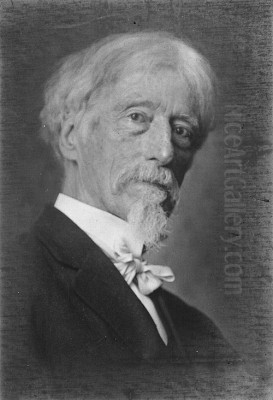
Edward B. Gay stands as a significant, if sometimes overlooked, figure in the landscape of American art during the latter half of the 19th and early 20th centuries. Born in Ireland in 1837 and passing away in Mount Vernon, New York, in 1928, Gay's long life spanned a period of immense change both in the United States and in the world of art. An immigrant who found his artistic voice in the fields, rivers, and coastlines of his adopted homeland, Gay became a respected painter known primarily for his faithful and evocative depictions of the American countryside, particularly the pastoral scenes of New York State and the Hudson River Valley. His journey reflects the experiences of many immigrants who contributed significantly to American culture, while his art provides a valuable record of the nation's landscapes before the full onset of modern industrialization.
Gay's work is often associated with the later phases of the Hudson River School, yet it also shows the subtle influences of European movements like the Barbizon School, resulting in a style that balanced American traditions of detailed realism with a growing interest in atmosphere and painterly effect. He was a dedicated member of the New York art establishment, achieving recognition through institutions like the National Academy of Design, and his works found homes in important public and private collections. This exploration delves into the life, career, artistic style, and legacy of Edward B. Gay, placing him within the context of his contemporaries and the artistic currents of his time.
Early Life and Artistic Awakening in Albany
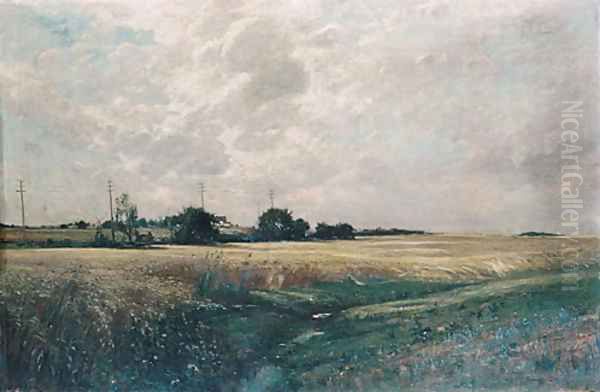
Edward B. Gay's story begins not in America, but in Dublin, Ireland, in 1837. His formative years were marked by the devastating Great Famine (An Gorta Mór) that ravaged Ireland in the mid-1840s. Like countless other Irish families seeking refuge and opportunity, the Gays emigrated to the United States, settling in Albany, New York. This move proved pivotal for the young Edward, placing him in an environment where his nascent artistic talents could be nurtured. Albany, at that time, was a burgeoning city with a growing cultural scene, and it was here that Gay first began to seriously pursue painting.
His initial artistic inclinations were encouraged and guided by several local painters who were already establishing their reputations. Notably, he received instruction and inspiration from James Hart and William Hart, brothers who were themselves immigrants (from Scotland) and would become prominent figures in the Hudson River School movement. Another key early influence was George Henry Boughton, an English-born painter who spent significant time in Albany before achieving fame in London. Under their tutelage, Gay likely honed his foundational skills in drawing and painting, absorbing the prevailing interest in landscape that characterized American art of the period. This early exposure to established artists provided him with a crucial starting point for his own artistic journey.
European Studies and Return to America
Seeking to further refine his skills and broaden his artistic horizons, Edward B. Gay followed a path taken by many ambitious American artists of his generation: he traveled to Europe for formal study. In 1862, he made his way to Germany, enrolling in the art academy in Karlsruhe. There, he studied under respected figures such as Johann Wilhelm Schirmer, a landscape painter known for his detailed and somewhat romanticized style, and Karl Friedrich Lessing, a prominent painter associated with the Düsseldorf school, known for both historical subjects and dramatic landscapes.
However, Gay's experience with European academic training was reportedly underwhelming. Sources suggest he found the rigid methodologies and perhaps the prevailing artistic tastes less inspiring than he had hoped. This reaction was not entirely uncommon among American artists who sought European validation but ultimately found their truest inspiration back in the landscapes and light of their own country. After approximately four years abroad, Gay returned to the United States in 1866, bringing back technical skills but seemingly reaffirming his commitment to depicting the American scene. His European sojourn, while perhaps not fulfilling in the expected ways, likely contributed to his technical proficiency and provided a comparative framework for his developing style.
Establishing a Career in New York
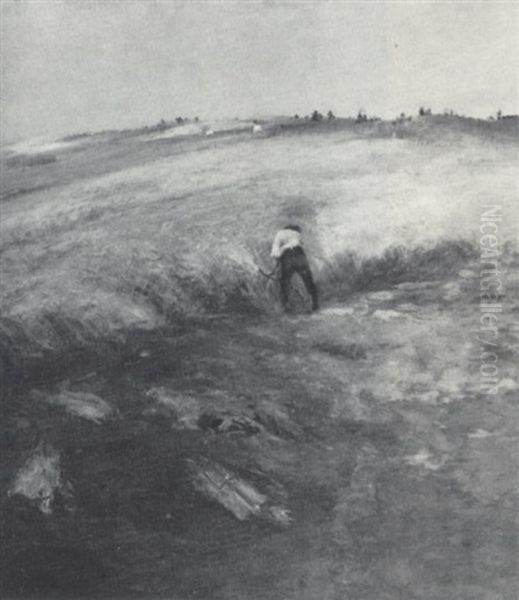
Upon his return from Europe, Edward B. Gay did not immediately settle down. He spent a brief period living and likely working in New York City, the undisputed center of the American art world. This would have exposed him to a wider range of artistic activity, galleries, and fellow artists. However, he soon sought a location that perhaps better suited his artistic temperament and subject matter preferences. He moved out of the bustling metropolis to the suburban town of Mount Vernon, located in Westchester County, New York.
Mount Vernon would become his primary residence and base of operations for the remainder of his long life. The surrounding landscapes of Westchester County, with their rolling hills, fields, farms, streams, and proximity to the Long Island Sound, provided him with ample subject matter. He established a studio there and became deeply connected to the local scenery. Additionally, Gay later established a summer residence and studio in Cragsmoor, an artists' colony situated in the Shawangunk Mountains of Ulster County, New York. This location, also favored by artists like E. L. Henry and Charles Courtney Curran, offered dramatic vistas and a different kind of rural beauty, further enriching his repertoire of landscape subjects. His choice of residence reflected his dedication to painting the specific character of the northeastern American landscape.
Artistic Style: Realism and Atmosphere
Edward B. Gay's artistic style is primarily characterized by realism, particularly in his faithful rendering of specific locations. Unlike some of his Hudson River School predecessors, such as Thomas Cole or Frederic Edwin Church, who often imbued their landscapes with grand narratives or allegorical meaning, Gay generally focused on capturing the quiet beauty and specific details of the scenes before him. His work often depicts tranquil, pastoral views – expansive fields under changing skies, meandering rivers reflecting light, quiet stretches of coastline, and the gentle contours of the New York countryside.
He possessed a keen sensitivity to the effects of light and atmosphere, qualities that became increasingly important in American landscape painting during the latter half of the 19th century. While his earlier works might adhere more closely to the detailed precision associated with the mid-century Hudson River School aesthetic, his style evolved over time. He was noted for his ability to capture the particular quality of light at different times of day and during different seasons, lending an air of authenticity and immediacy to his canvases. His commitment was to representing what he saw, avoiding overt romanticization or idealization, which aligns him with the realist tendencies gaining ground in American art.
The Influence of the Barbizon School
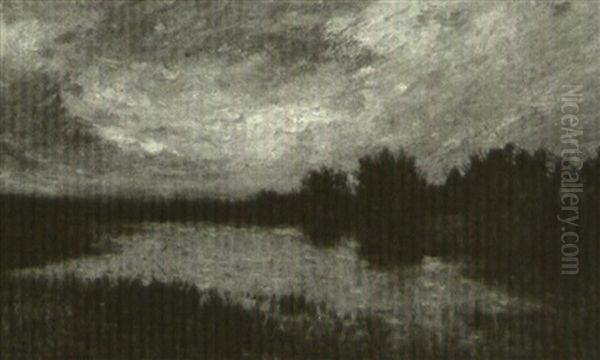
While rooted in American landscape traditions, Edward B. Gay's work also reveals the subtle but discernible influence of the French Barbizon School. This mid-19th-century movement, centered around the village of Barbizon near the Forest of Fontainebleau, included artists like Jean-Baptiste-Camille Corot, Jean-François Millet, and Théodore Rousseau. They championed painting directly from nature (en plein air), focusing on humble rural scenes and emphasizing mood, atmosphere, and tonal harmony over precise detail or dramatic effect. Their brushwork was often looser and more expressive than academic standards dictated.
This influence is seen in the gradual softening of Gay's style over his career. While never fully abandoning representational accuracy, his later works often exhibit a broader handling of paint, a greater emphasis on tonal unity, and a more intimate, poetic sensibility. This aligns him with other American artists of his generation, such as George Inness and Alexander Helwig Wyant, who were more profoundly impacted by Barbizon aesthetics and helped pave the way for American Tonalism and Impressionism. Gay's engagement with Barbizon ideas represents a bridge between the detailed realism of the Hudson River School and the more atmospheric, subjective approaches that gained prominence towards the end of the century.
Representative Works and Subjects
Edward B. Gay was a prolific painter, and while a comprehensive list of all his works is extensive, certain subjects and specific paintings stand out as representative of his oeuvre. His primary focus remained the landscapes of New York State. He frequently depicted the rolling fields and farmlands of Westchester County, often capturing scenes of agriculture, such as hay harvesting or grain fields under wide skies. Titles like "Broad Acres," "Harvest Time," and "The Fields of Mount Vernon" likely evoke these typical subjects, emphasizing the productivity and pastoral beauty of the region.
The waterways of the area were another recurring theme. He painted views along the Hudson River, though perhaps less focused on the dramatic, panoramic vistas favored by earlier Hudson River School artists and more on quieter stretches. He also extensively painted scenes along the Long Island Sound and its inlets, such as "East Chester Creek." Works like "Washed by the Sea" suggest his interest in coastal landscapes, capturing the interplay of water, land, and sky. Paintings such as "The Month of May" likely capture the specific atmospheric effects and burgeoning life of springtime in the Northeast. His works are generally characterized by a sense of tranquility and a deep affection for the familiar, cultivated landscape. He also undertook mural commissions, notably for the Mount Vernon Public Library, demonstrating his ability to work on a larger scale for public spaces.
Context within the Hudson River School
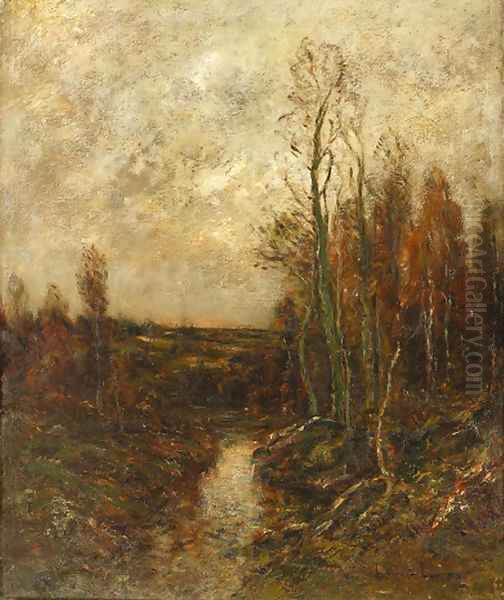
Edward B. Gay's career unfolded during the later years of the Hudson River School's dominance in American landscape painting. While he shared the school's fundamental reverence for nature and its commitment to depicting American scenery, his work often represents a transition away from the movement's earlier, more overtly nationalistic or sublime modes, as exemplified by founders like Thomas Cole and Asher B. Durand, or the spectacular canvases of Frederic Edwin Church and Albert Bierstadt.
Gay's focus on more intimate, localized, and often cultivated landscapes aligns him with the pastoral wing of the Hudson River School. His contemporaries included artists like Sanford Robinson Gifford, who was similarly fascinated with the effects of light and atmosphere (Luminism), and Jervis McEntee, known for his melancholic autumnal scenes. Gay's connection to the Hart brothers (James M. Hart and William M. Hart, often referred to interchangeably with James and William Hart in sources) further solidifies his place within this artistic milieu. While the movement's initial energy was waning by the time Gay reached artistic maturity, he carried forward its dedication to landscape, adapting it with influences from abroad and contributing to its evolution.
Professional Life and Recognition
Edward B. Gay was actively involved in the professional art organizations of his time, securing his reputation within the New York art establishment. His most significant affiliation was with the prestigious National Academy of Design. He exhibited his works there regularly and was elected an Associate Member (ANA) before achieving the status of full Academician (NA) in 1907. This recognition signified his acceptance into the highest ranks of the American art world at the time.
Beyond the National Academy, Gay was also a member of the New York Artists' Fund Society, an organization dedicated to supporting artists in need, indicating a sense of community and professional responsibility. He also held membership in the Lotos Club, a prominent gentlemen's club in New York City known for its association with arts and letters, which often hosted art exhibitions and provided a venue for artists to socialize and network with patrons and colleagues. His participation in these organizations, combined with regular exhibitions, ensured his visibility and contributed to the steady market for his paintings throughout his career. His works were acquired by major institutions, including the Metropolitan Museum of Art in New York and the Minneapolis Institute of Art, further cementing his professional standing.
The Cragsmoor Art Colony Connection
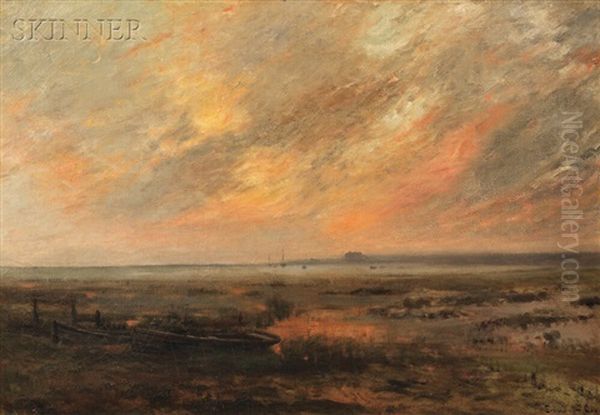
Edward B. Gay's connection to the Cragsmoor art colony in the Shawangunk Mountains is another important aspect of his later career. Starting in the late 19th century and flourishing in the early 20th, Cragsmoor attracted numerous artists drawn to its scenic beauty, healthy environment, and congenial atmosphere. Gay built a summer home and studio there, joining a community that included figures like the genre painter E. L. Henry, the Impressionist Helen Turner, and landscape painter Charles Courtney Curran.
His presence in Cragsmoor provided him with fresh landscape subjects, distinct from the gentler terrain of Westchester County. The mountain vistas, dramatic rock formations, and unique atmospheric conditions of the Shawangunks likely offered new challenges and inspiration. Spending summers there allowed him to work outdoors and engage with fellow artists in a relaxed setting, potentially fostering creative exchange. His involvement with Cragsmoor underscores his lifelong commitment to landscape painting and his participation in the broader artistic communities that shaped American art during this period.
Beyond the Easel: Business Ventures
Interestingly, Edward B. Gay's life was not solely dedicated to painting. The provided information indicates an involvement in business affairs, specifically related to family enterprises and property management. It is mentioned that he acquired and managed plantations, such as the Magnolia Mound Plantation (presumably in the South, though details are sparse in the snippets), possibly through defaulted mortgages or inheritance. This suggests a level of financial acumen and responsibility extending beyond his artistic practice.
His engagement in managing agricultural enterprises, potentially involving crops like sugar and cotton, presents a complex facet of his biography, reflecting the economic realities and investment practices of the era. While seemingly distinct from his landscape painting, this business involvement may have provided a degree of financial stability that supported his artistic career. It also hints at the broader economic networks that artists, like other professionals of the time, might navigate. This aspect adds another layer to understanding Gay as an individual operating within the specific historical and economic context of late 19th and early 20th century America.
Legacy and Conclusion
Edward B. Gay's legacy rests on his consistent and sensitive portrayal of the American landscape, particularly the northeastern regions where he lived and worked. As an Irish immigrant who embraced his adopted country, he contributed to the rich tradition of American landscape painting, chronicling the fields, rivers, and coastlines of New York with fidelity and affection. His work bridges the detailed realism of the mid-century Hudson River School with the emerging interests in atmosphere, light, and painterly effects influenced by European movements like the Barbizon School.
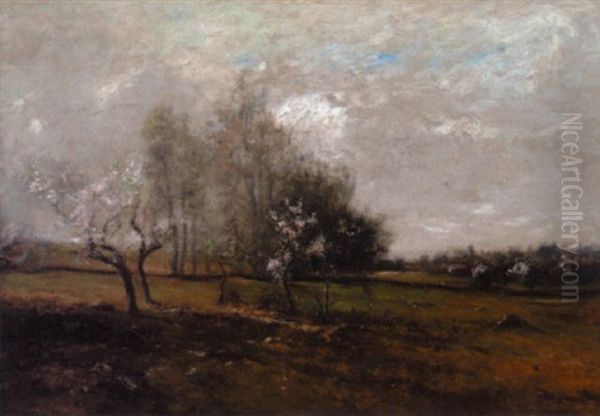
While perhaps not as revolutionary as some of his contemporaries who fully embraced Impressionism or Modernism, Gay remained a respected figure throughout his long career. He achieved significant professional recognition through the National Academy of Design and other institutions, and his paintings were sought after by collectors and museums. He stands as a testament to the enduring appeal of representational landscape painting and offers a valuable visual record of the American countryside during a period of transition. His art invites viewers to appreciate the quiet beauty of the natural world, rendered with sincerity and skillful observation by an artist deeply connected to his chosen home. Edward B. Gay's contribution enriches our understanding of the diverse currents within American art at the turn of the twentieth century.